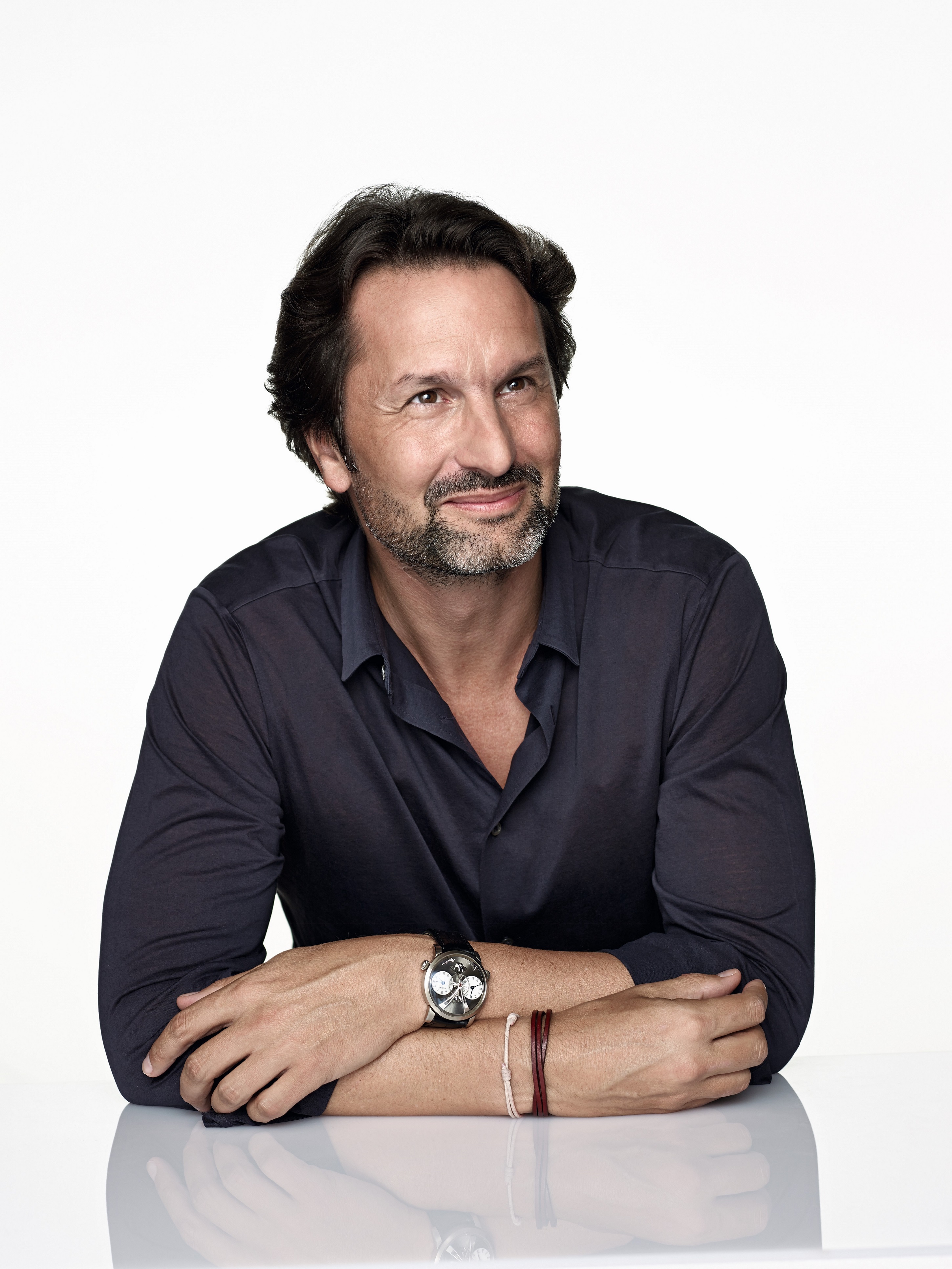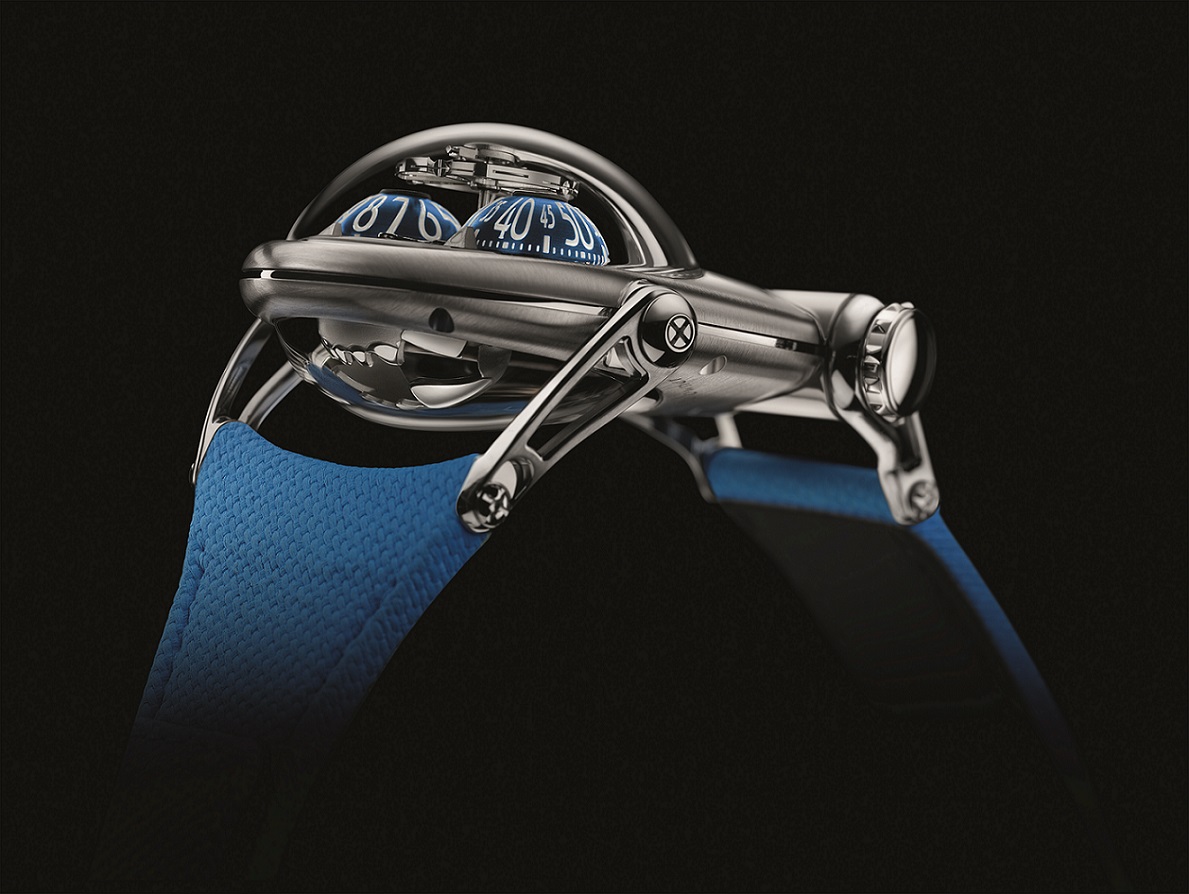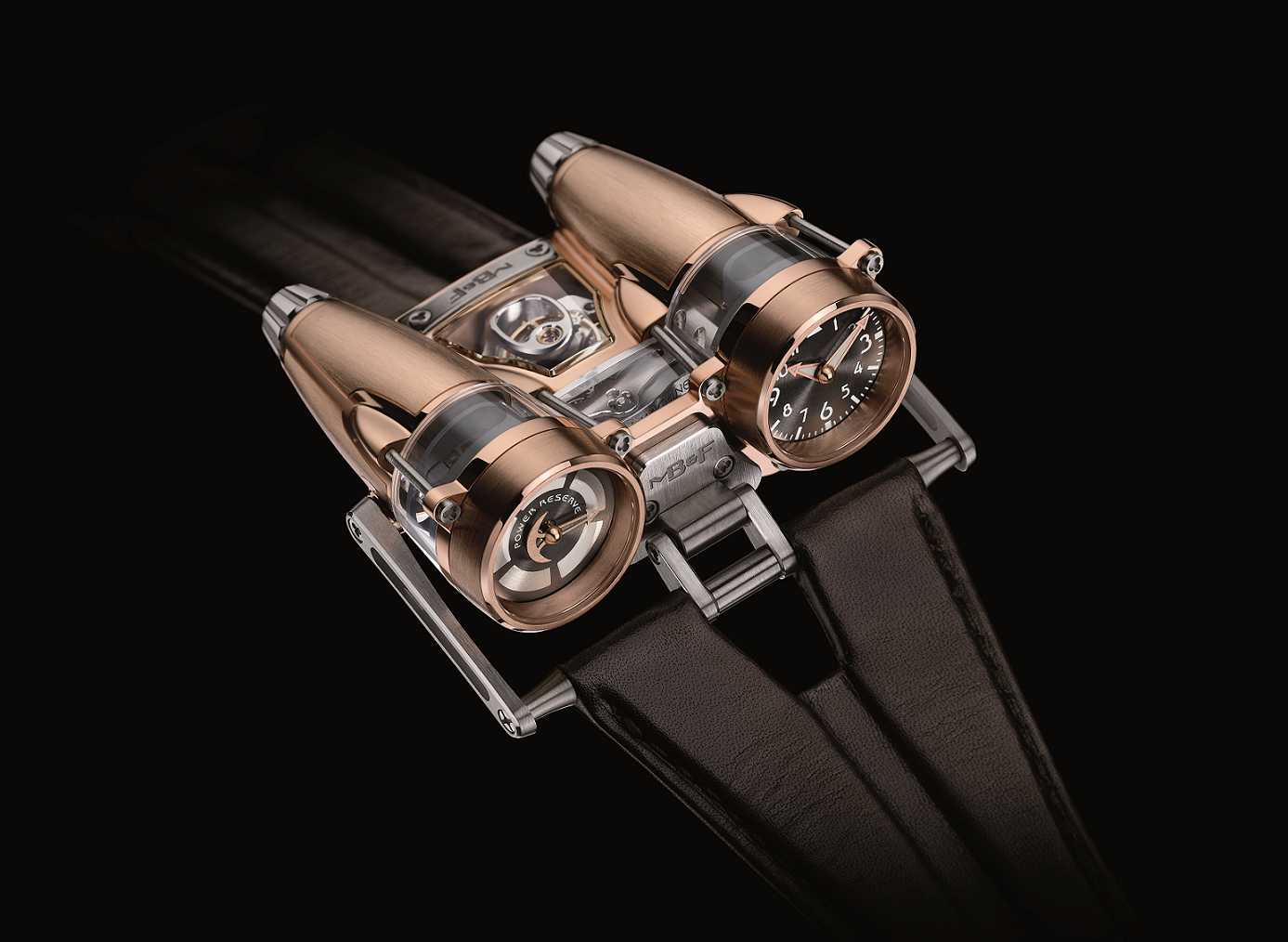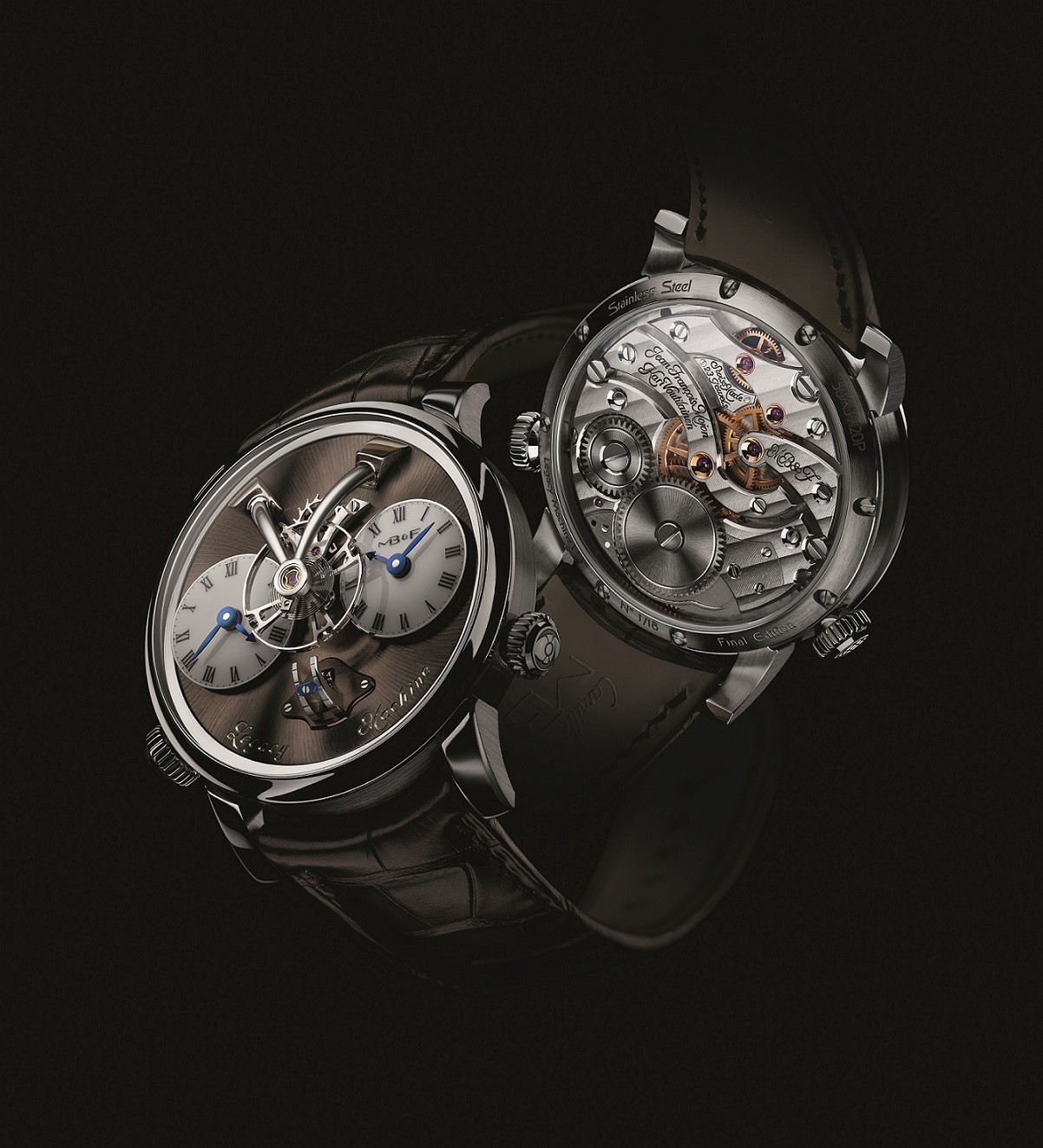Ever since I started learning about watches, one designer and his brand in particular has always stood out to me. That designer is Max Büsser, Founder and Creative Director of MB&F (Maximilian Büsser & Friends). The first time I saw these pieces, my mind was opened to an entirely new idea of what a watch could be; I found the creativity behind them to be inspiring, and I consider myself exceptionally fortunate to have had the chance to sit down and have a conversation with the man himself…
In Conversation with Max Büsser

Max Büsser - CEO and Founder of MB&F, picture: MB&F
WA: To start with, could you tell me a little bit about your career to date and how you found your way into the world of watches?
MB: I found watchmaking during my university years, I did a masters in Microtechnology Engineering and graduated 29 years ago in an age where mechanical watchmaking was dead, and I bumped into that world during my studies by chance, and started getting really interested in it. By an incredible twist of fate, I bumped into the CEO of Jaeger-LeCoultre on the ski slope – not while we were skiing! – but I went to a café with some friends and he was there. We had spoken a couple of times before, and we talked, and he asked if I would like to come and visit the factory. After 3 hours of him selling the dream and how he was going to save Jaeger-LeCoultre, he told me he would create a job for me as Product Manager of Jaeger. I had to think about it as watchmaking was dead, and going to work and live in the Vallée de Joux was not exactly an exciting prospect for a young man of 24, and he told me this incredible phrase which has so changed my life:
“Do you want to be one amongst 200,000 people in a big corporation, or do you want to be one of three or four of us who are going to save Jaeger?”
and the next day I called him up, and said “OK”.
It’s a very lucky time of my life that I started in an era where watchmaking was virtually bankrupt. Why? Because we were crazy geeks talking to crazy geeks. People in the watch industry with us were all nuts, there was no money, no glam, no celebrities, no influencers. There was nothing, it was just a few crazy guys trying to create beautiful watches, and on the other hand there were a few crazy clients who still didn’t want quartz, looking for something beautiful. It was an amazing time; I loved those moments. I did seven incredible years at Jaeger, I loved my time there, and then I got headhunted to take over Harry Winston timepieces – I was 31, I thought it was a joke, and after I don’t know how many interviews they gave me the job. This is 1998, and what I didn’t know was that Harry Winston timepieces was on the verge of bankruptcy, and the week after I signed my contract, Harry Winston the brand was put on sale. I was suddenly, at 31, given the keys of a virtually bankrupt company, owned by a company with no money that was up for sale, and told to just deal with it.
Looking back, this is one of the defining moments of my life that is going to allow me to create MB&F seven years later. I often say I was very lucky to enter Jaeger when it was coming out of bankruptcy, and enter Harry Winston when it was about to go into bankruptcy, because in both cases, both companies were so badly off and so small that for a youngster like me it was an incredible learning curve, and because I had gone through those two, I had the courage to create my own company. If I had worked in both companies when they were doing superbly well and were big companies, not only wouldn’t I have learned what I needed to create my own company, but I wouldn’t have had the courage.
That is the start of Harry Winston. It took us more or less a year and a half to stabilise it, and then from 2000 to 2005 it was crazy – we took that company from 8 to 80 million dollars, we created the Opus, we created the factory… when I arrived, there were seven people linked directly to me, when I left we were 80 with 5 levels of hierarchy. We had our own engineers, our own machines making our own parts, we had integrated everything in house and that was all done in five years. It was an insane learning curve.
While that was happening, I had what most men want, I had power, money, recognition, and the bigger the company was growing, the less I was enjoying myself and I didn’t understand why until I realised that this was so not what I wanted to do in my life. I come from a family with no money, so having arrived there when I actually didn’t expect to was already extraordinary, but then I felt guilty about not enjoying this incredible life I was living, and I realised this is not who I am. The little boy who was very creative had become a marketeer – he had sold out, he was creating products because he thought they would sell, not because he liked them. The little boy who had been brought up by incredibly respectful, honest and kind parents had to deal with horrible people in this industry; because they had power, because they had money, I had to invite them for lunch. I was thinking “why do I accept this? Why do I work with these horrible people?” – not my team of course but everything around it, and that’s when I started dreaming of MB&F, which came to life on 25th July 2005. I set up the company and it was just me in my flat, with all my savings put in the company. I would be all alone for two years, we were two for third year and three for the fourth year, and we are 25 now in the company and we have integrated an incredible amount of things into it, and we have come out with 18 calibres in 15 years. All with auto-finance, with no investor, no credit lines, all from my savings which we have put back into the company for 15 years.

MB&F logo, picture: MB&F
WA: When you were thinking about creating MB&F, did you have a vision in mind when you set out, and how would you compare MB&F today with what that vision might have been?
MB: I don’t think I had a vision, I had two products in HM1 and HM2, which didn’t even look like HM2 at that point, and a sketch of HM3. I knew that I had to do it, and that if I didn’t do it, I would hate myself for the rest of my life. I knew the fundamentals of what the company needed to be, and they are still the fundamentals today, meaning to create for myself kinetic art which gives time, 3D machines which give time. To only work with people who share the same values, the same integrity, with the same passion, enthusiasm. That was the beginning, and that is still the case today.
Did I imagine all the products we were going to come out with? I hadn’t even thought about them at that point; would I have imagined that we would have created an art gallery concept – the M.A.D Gallery – absolutely not. Would I have imagined that I would have created clocks and music boxes – no, absolutely not. Did I imagine I was going to create a round watch? Absolutely not! When I created MB&F that was the end, I am not going to create any boring round watches any more, this is now going to be 3D sculptures, and then I created the Legacy Machine. I had the fundamentals, and a lot of rage at the time, and I just did it. I think that’s what defines a lot of entrepreneurs, is being very unconscious of a lot of things that could happen to you, otherwise you wouldn’t do it.
WA: I visited Geneva last year with my girlfriend and we went to the M.A.D Gallery there, and we must have been in there for a good hour and a half, two hours looking at everything – it was brilliant and we loved it. How did you come up with the concept?
MB: The M.A.D Gallery is a typical gut feeling idea which had no fundamentals business-wise, and my own team was even looking at me going “what are we doing with this thing?!” Nobody in my team had any experience of retail, me included. Let’s not forget that when we launched the M.A.D Gallery in 2011, MB&F was HM1, HM2, HM3 and HM4, and most watch retailers when they looked at what we do, and they’d go “this is not a watch” which, defacto, I was actually agreeing with them – this is not a watch, that is not what we’re doing. Then I decided, we should probably be in art galleries, we shouldn’t be in watch retailers, so I started going to see art galleries, and they all looked at me going “this is a watch!” and I realised something is wrong here. We were in a middle ground that nobody understands, and I thought maybe if I curate mechanical art which not only do I love, but if people saw this other mechanical art, maybe they would understand better what I am trying to achieve. So for me, it was like a decoding process, so we went ahead and did it and hoping we would not lose any money on it, and it took a life of its own and in nine years there’s now four M.A.D Galleries in the world and we are in discussions for a few others. We have curated so many incredibly fantastic artists who most people have never heard of, and who often cannot find a gallery to showcase their art because traditional galleries just don’t get it – they’re not interested in that. They want their paintings, they want their photos and maybe a few sculptures, but not what you’ve seen in our gallery. I often relate to it as an orphanage, where we welcome orphans who are orphans of the art world, and actually make my heart beat super-fast because I love what they do.
WA: Is London on the list to get a M.A.D Gallery?
MB: It was, and then of course between Brexit and Covid…! {laughs} We had found a fantastic partner who was gung-ho to do it, then when Brexit happened… so I think we all need to reconstruct in the next couple of years, I think there’s going to be… actually, I have no idea what the hell is going to happen, but I’m going to assume that nothing is going to be like before!
WA: I think that’s a safe bet! With your MB&F pieces, I’ve heard you describing them as crazy, and about how you need to be different these days to stand out. There are a few pieces you could describe as different – things like Ressence and HYT – so what do you think the difference is between being different, and being crazy?
MB: I think craziness is in the eye of the beholder, like beauty, meaning what is completely normal for me is completely insane for somebody else. I love Ressence, I love Benoît, I think the guy is incredible. He is the epitome of a creator-entrepreneur as I love them, and I think he has just defined a whole new territory for himself and for his brand. I don’t see it as crazy, but I see it as one of the very few creations in the watch world which I love, makes me happy, gets my adrenaline spiked. It speaks to me. I don’t think you need to be crazy to succeed, though it is incredibly complicated today to succeed as a small entrepreneur in the watch world. The barriers to entry have multiplied by hundreds between now and fifteen years ago when I first started and I have got a lot of admiration for the guys who start to create something today because it is way more difficult.
“I think craziness is in the eye of the beholder…”
I think you need to have a reason to exist. It has to be a reason for you and a reason for the watch world. The reason cannot be money, cannot be business because you’re absolutely doomed for failure if that’s the case, it has to be your incredibly strong desire to express yourself in a creative way. Now, I think Ressence is a perfect example, but you can have a completely different register, a Kari Voutilainen who I absolutely love and worship also, who is incredibly classic, but watchmaking needs Kari, and for me watchmaking needs Ressence. They’re expressing themselves. They’re not doing this because they’re expecting money, they’re doing this because it’s the only thing they know how to do and they’re basically writing their autobiography. They aren’t looking at the market going “the market wants something with hours and minutes turning round”, or “the market wants a direct escapement”. They’re not into that, they’re into “this is extraordinary, I need to do it, and then we’ll find the client if we’re lucky.” That’s where watchmaking joins up with art, because art is not consumer driven; Kari and Benoît are artists in their domain. Does that make sense?
WA: Yes, absolutely! So, when you get your own ideas and inspirations, do you get a seedling of an idea or the full big picture?
MB: It has evolved enormously over the years. My very first HM, HM1, was a labour of love – hundreds of hours of doubt: shall I put that screw here, what will that look like, what will that lug look like, what will the bezel look like – doubt doubt doubt! Today, the best example is the Bulldog which we launched a month ago, it appeared to me out of the blue. Before, I was doubting, resketching, doubting, resketching, and now – boom! It just arrives in my mind. I think you can train your brain to create, I think that’s basically what I’ve been doing for 15 years without realising it – I’m saying here to create for yourself, I’m not saying as a marketeer “what does the market want”, but “what do I want”. Everything in our society supresses the need to express ourselves individually, society hates individuals and it wants everybody to think in the same way. I’m more or less schizophrenic – one part is completely free and the other one is intensely focused on reality. That’s my challenge in my life and has been for the last 15 years.

MB&F HM10 Bulldog, picture: MB&F
WA: Which of your pieces ended up closest and furthest from how you imagined? Which was the biggest technical challenge?
MB: The piece that arrived pretty much exactly how I imagined it is Bulldog, because I think I’ve come to a point in my life I came to five years ago, and you’re going to see other pieces coming out which I have imagined since, where now I’m pretty much focused and I see what I want. The piece which started its life in one way and ended up completely different? There are two of them: the first one was HM4, the Thunderbolt, which started off more or less as a flat watch with a balance wheel and two dials, which ended up being these two reactors. It really was months and months of redesigning and seeing the project become more and more 3D. The second one was Legacy Machine One, which was going to be a Horological Machine originally, but for the better part of eight or nine months I just couldn’t manage to get what I wanted. I wanted to have a watch that was three cylinders, in one cylinder you would have the balance wheel, and in the other two cylinders you’d have the time and the power reserve. No matter what I designed, it always looked like a piece unique that Vianney Halter did for Goldpfeil in 2001, and my ego would not let me allow that! {laughs} It looked like something which has already been done. So, after nine months of trying everything I could, one day I was just like “you know what, why don’t we just try that” – and everyone in my team looked at me saying “what are you talking about? A round watch? With white dials and Roman numerals? What is this?!” So, I said let’s think differently, let’s make a tribute, but it didn’t start its life like that at all.

MB&F HM4 Thunderbolt, picture: MB&F

MB&F Legacy Machine 1, picture: MB&F
WA: You kind of touched on it then, when can we look forward to seeing the next MB&F creations?
MB: So, a month ago you saw Bulldog, we’ve had an insane last 12 months! About 12 months ago, Flying T came out, my very first piece for the women in my life in March. December last year was Thunderdome, this incredible three-axis regulator with Eric Coudray and Kari [Voutilainen].
WA: That blew my mind when that one came out!
MB: That was an incredible project! And now, March was Bulldog. We just came out with 3 fully new calibres in 12 months. I can’t think of any brand who comes out with 3 completely new calibres, I mean I’m not saying modification of something existing… completely new calibres in 12 months. So, we are going to pace ourselves now until next year, which is only 8 months away! And so next year… next year is a strong year. First of all, it’s going to be the tenth anniversary of Legacy so we are preparing something for that and I’m excited, you’re going to see that at the beginning of next year, and at the end of next year if all goes well another amazing piece. I’m not sure because of course with Covid-19 I had to cut so much in our budgets so I don’t know how that’s going impact the project schedule. It’s a really amazing project, so hopefully if everything goes well we should have two really cool projects.
WA: Fingers crossed! I’ll look forward to seeing them!
MB: Me too!
WA: Before we go, I have to ask, what do you have on your wrist today?
MB: {Max shows his beautiful Legacy Machine Perpetual}
WA: That’s my favourite piece of yours, the Legacy Perpetual
MB: Thank you!
WA: And finally, what do you have in your watch box? What kind of pieces do you have in your personal collection?
MB: I’m a watch guy, I buy watches. If there’s one place I spend my money it is in watches – people think that because I create watches, I don’t buy other brands. Of course I buy other brands, I buy all sorts of watches. I’ve got two axes to my collection: the first of course is the icons of our world, what our world was built on. I mean like in architecture, the Le Courbusier chair that you need to have, or the Herman Millers, or the Eames. If you’re into chairs for example, you’ve got the basics. They are the great designs of the Twentieth Century. Now of course that means there’ll be a Reverso, a Panerai, a Nautilus, a Speedmaster, a Royal Oak, Rolex of course, all the greats which have built our industry. And then of course, what really makes me happy and makes my heart beat faster, is always pieces from the independents with whom I have worked, and I know their story, and I know all the hardships they’ve gone through to create their brand. I’m so lucky to have a Kari [Voutilainen], I’ve got an Urwerk, a Sarpaneva, even a designer like Silberstein – I’ve got a couple of Silbersteins. Alain Silberstein is not a watchmaker, he’s been a designer for 25 years, he’s created the most innovative watches in the world, and it’s only now that he’s bankrupt that everyone wakes up to the fact that he was a genius – everyone’s scrambling to try and find his pieces. When he wasn’t bankrupt, nobody wanted to buy them but what he did was absolutely ground-breaking in design, but not as a watchmaker. I’ve got all these pieces, oh and a Peter Speake-Marin from the days of Peter of course. The only watch I’m missing actually from the people I’ve worked with is an F.P. Journe. When I wear these pieces, I think of my friends, not because they’re my friends, but because I admire them and I know what they’ve gone through to create that piece, which is a million times more difficult than any big brand has had to endure.
WA: It’s about the story that’s attached to it.
MB: Absolutely!
WA: Thank you for taking the time to chat with me!
MB: Pleasure, thank you very much!
To learn more about Max Büsser and MB&F, please visit MB&F
Share your thoughts with us via our Contact page, or via our Instagram
Don’t forget to check out the Interviews Page for more!
Other similar articles:

